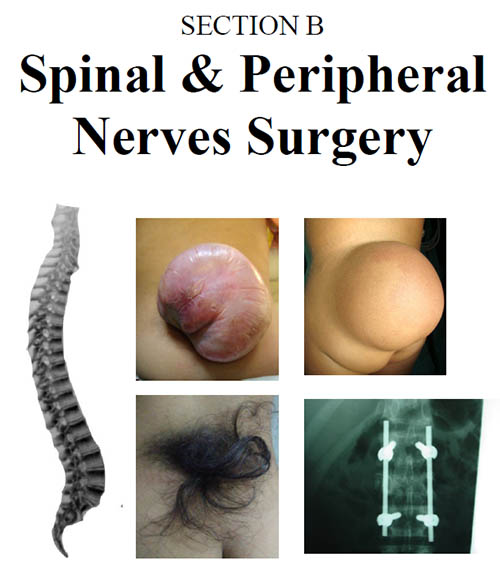Spectrum of Different Spinal Disorders Presenting to Neurosurgical Department of Public Sector Tertiary Care Hospitals of Peshawar
DOI:
https://doi.org/10.36552/pjns.v23i4.391Keywords:
Traumatic spinal injuries, Non traumatic spinal injuries, epidemiologyAbstract
Objectives: To assess the spectrum of different spinal disorders presenting to the Neurosurgical department of public sector tertiary care hospitals of Peshawar.
Materials and Methods: This was a retrospective study carried out in the Neurosurgery departments of two public sector tertiary care hospitals in district Peshawar from January 2012 to December 2018. Our inclusion criteria comprised of all those patients who were having spinal abnormalities irrespective of age and gender, admitted either via emergency or OPD. We excluded those patients who were dead on arrival or whose data was lacking including those who did not do their follow up and those who were not given consent for the study.
Results: Out of total 5,579 patients, male to female ratio was 1:1.7. The age range was from 6 days to 78 years. Elective cases were 63.61% (n = 3,549) and emergency were 36.37% (n = 2,030). TSCI were 35.01% (n = 1,953) and NTSCI were 3,626 (n = 64.99%). Out of all patients, 91.03% (n = 5,079) were treated surgically. About 79% (n = 4,406) had a good outcome.
Conclusion: We collected data and made a survey of the spectrum of different spinal abnormalities resulting from various etiologies focused over the last 6 years. We found a variety of cases presenting to our departments of neurosurgery. Non traumatic spinal injuries are more frequent as compared to traumatic ones.
References
2. McKinley WO, Seel RT, Gadi RK, Tewksbury MA. Nontraumatic vs. traumatic spinal cord injury: a rehabilitation outcome comparison. Am J Phys Med Rehabil. 2001; 80: 693–699.
3. Majdan M, Brazinova A, Mauritz W. Epidemiology of traumatic spinal cord injuries in Austria 2002-2012. Eur Spine J. 2015; 25: 62–73.
4. Löfvenmark I, Norrbrink C, Nilsson-Wikmar L, Hultling C, Chakamdinakira S, Hasselberg M. Traumatic spinal cord injury in Botswana: characteristics, aetiology and mortality. Spinal Cord, 2015; 53: 150–154.
5. Wyndaele M, Wyndaele J-J. Incidence, prevalence and epidemiology of spinal cord injury: what learns a worldwide literature survey? Spinal Cord, 2006; 44: 523–529.
6. New PW, Cripps RA, Bonne Lee B. Global maps of non-traumatic spinal cord injury epidemiology: towards a living data repository. Spinal Cord, 2014; 52: 97–109.
7. New PW, Sundararajan V. Incidence of non-traumatic spinal cord injury in Victoria, Australia: a population based study and literature review. Spinal Cord, 2008; 46: 406–411.
8. McKinley MO, Tewksbury MA, Goodbout CJ. Comparison of medical complications following non-traumatic and traumatic spinal cord injury. J Spinal Cord Med. 2002; 25: 88–93.
9. Center, N.S.C.I.S. Spinal Cord Injury Facts and Figures at a Glance. The Journal of Spinal Cord Medicine, 2014; 37: 117-118.
Doi:10.1179/1079026813z.000000000249.
10. Singh, A., Tetreault, L., Kalsi-Ryan, S., Nouri, A. & Fehlings, M. G. Global prevalence and incidence of traumatic spinal cord injury. Clin Epidemiol. 2014; 6: 309-331. Doi:10.2147/CLEP.S68889.
11. Chen Y, He Y, De Vivo M. J. Changing Demographics and Injury Profile of New Traumatic Spinal Cord Injuries in the United States, 1972-2014. Arch Phys Med Rehabil. 2016; 97: 1610-1619. Doi:10.1016/j.apmr
12. Ibrahim A, Lee KY, Kanoo LL, Tan CH, Hamid MA, Hamedon NM et al. Epidemiology of spinal cord injury in hospital Kuala Lumpur. Spine, 2013; 38: 419–424.
13. Fielingsdorf K, Dunn RN. Cervical spine injury outcome—a review of 101cases treated in a tertiary referral unit. S Afr Med J. 2007; 97: 203–207.
14. Bjornshave Noe B, Mikkelsen EM, Hansen RM, Thygesen M, Hagen EM. Incidence of traumatic spinal cord injury in Denmark 1990-2012: a hospital-based study. Spinal Cord, 2015; 53: 436–440.
15. Alshahari SS, Cripps RA, Lee BB, Al-Jadid MS. Traumatic spinal cord injury in Saudi Arabia: an epidemiological estimate from Riyadh. Spinal Cord, 2012; 50: 882–884.
16. Mathur N, Jain S, Kumar N, Srivastava A, Purohit N, Patni A. Spinal cord injury: scenario in an Indian state. Spinal Cord, 2015; 53: 349–352.
17. Costacurta ML, Taricco LD, Kobaiyashi ET, Cristante AR. Epidemiological profile of a pediatric population with acquired spinal cord injury from AACD: Sao Paulo/Brazil. Spinal Cord, 2010; 48: 118–121.
18. Ones K, Yilmaz E, Beydogan A, Gultekin O, Caglar N. Comparison of functional results in non-traumatic and traumatic spinal cord injury. Disabil Rehabil. 2007; 29:1185–1191.
19. DeVivo MJ, Chen Y. Trends in new injuries prevalent cases, and aging with spinal cord injury. Arch Phys Med Rehabil. 2011; 92: 332–338.
20. Scivloetto G, Farchi S, Laurenza L, Molinari M. Traumatic and non-traumatic spinal cord lesions: an Italian comparison of neurological and functional outcomes. Spinal Cord, 2011; 49: 391–396.
21. O’Connor P. Incidence and patterns of spinal cord injury in Australia. Accid Anal Prev. 2002; 34: 405–415.

Downloads
Published
Issue
Section
License
The work published by PJNS is licensed under a Creative Commons Attribution-NonCommercial 4.0 International (CC BY-NC 4.0). Copyrights on any open access article published by Pakistan Journal of Neurological Surgery are retained by the author(s).












